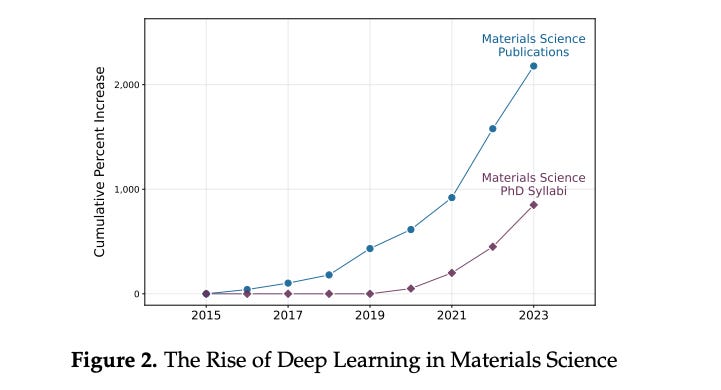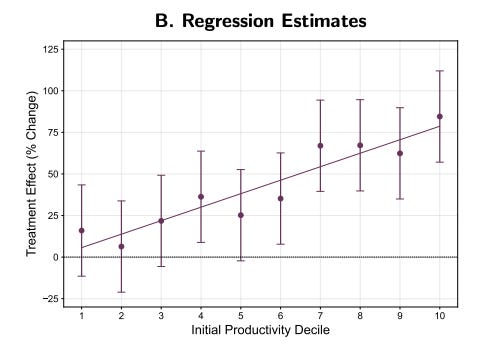Following up: AI-driven breakthroughs
Just a few weeks after my first post, we have some data on AI's ability to drive novel discovery in materials science
A few weeks ago, I wrote about AI’s potential to create breakthroughs in various fields. Today, I wanted to give a quick update because, as it turns out, my timing was very good.
Just a day before I published my post, a new paper validated this thesis in materials science.
Below are the headline findings from the paper covering new materials, patent filings, and downstream product innovation. All increased post AI adoption.
The paper concluded that AI-assisted researchers discovered 44% more materials, resulting in a 39% increase in patent filings and a 17% increase in new product innovation.
It’s no coincidence that this progress follows years of increased publications and PhD syllabi on Deep Learning.
Aside from the headline, I want to highlight three specific findings from the paper.
1/ AI-driven discoveries show creativity
Excitingly, the new materials discovered post-AI intervention were on average more novel than discoveries that were not aided by AI.
In my earlier post, I wrote:
Novel discoveries often require novel methods.
Like investing, you may generate some returns if you follow the momentum of what’s working, but the outsized returns come from non-consensus or overlooked ideas.
The methods, strategies, and products that drive step changes in frontier knowledge are similar. There’s only so much juice to squeeze from optimization.
The author of this new paper reaches a similar conclusion.
New materials discovered with AI have (1) lower average chemical similarity to existing materials, (2) a higher share of “highly distinct materials” (those in the bottom quartile of similarity), and (3) more distinct downstream patent filings.
The author concludes:
A central concern with applying machine learning to scientific discovery is its potential to amplify the “streetlight effect”—the tendency to search where it is easiest to look rather than where the best answer is likely to be. This worry stems from models being trained on existing knowledge, potentially directing search toward familiar but less promising areas (Khurana, 2023; Kim, 2023; Hoelzemann et al., 2024). In other words, AI might inefficiently favor exploitation over exploration. In materials science, this appears not to be the case. Instead, the tool increases the novelty of discoveries, leading to more creative patents and more innovative products.
2/ AI increases the distance between the best and the rest
Just as AlphaGo improved the skills of the world’s top Go players, AI has a similar impact on scientists. The author notes:
The tool disproportionately benefits scientists with high initial productivity, exacerbating inequality. Decomposing productivity into distinct skills, I show that differences in judgment—the ability to identify promising candidate compounds—explain nearly all of this heterogeneity.
The chart below shows that the higher the scientist’s initial productivity (further right), the greater effect that AI had on their productivity (the higher the bar).
Bottom decile scientists see almost no productivity improvement, whereas top decile scientists see a nearly 2x increase!
3/ Judgement is all you need
The reason the best scientists are the most productive post-AI? Judgment.
Below, you can see that the average work week shifts from one focused on idea generation and experimentation (~75% of time) with little judgment (~25% of time) to one where judgment becomes significantly more important (~40% of time post-AI).
As work output shifts from completing to-dos to thinking, those with the highest intellectual horsepower stand out even more.
Much more to come
It’s awesome to see early validation of the hypothesis that AI will advance frontier knowledge across fields. We’ll see the same in other fields beyond materials science very soon.
We’re on the brink of an explosion in new knowledge and a world where the best people become 10 or 100x more productive. If you haven’t figured out how to use AI to do your job faster, it’s time to start.
If you haven’t read the paper I reference in this post, I highly recommend it. While I did my best to hit the most salient points, there’s tons more insights in the original material.







